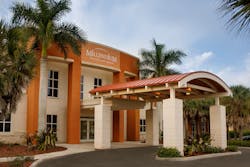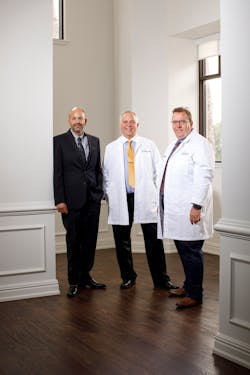At what feels to many like an inflection point in the forward evolution of the accountable care enterprise, and in particular in the evolving trajectory of the Medicare Shared Savings Program (MSSP), with senior officials at the Centers for Medicare and Medicaid Services (CMS) pushing down hard on providers to take on downside risk much faster, the need for exemplars of success is greater than ever. Fortunately for the industry, there have been some bright spots in MSSP ACO (accountable care organization) outcomes. One is in Florida, where the leaders of the Fort Myers-based Millennium Physician Group, a 400-plus physician group servicing at least 10 counties across the middle of that state, have empowered their practicing physicians with data to enhance care management.
For the 2017 MSSP performance year, Millennium earned more than $29.7 million in shared savings, up from $18.5 million in 2016, making it the No. 1 ranked ACO in the country in terms of shared savings, and No. 8 in the country in total savings at $42 million. This achievement is even more impressive considering only 34 percent of participating MSSP ACOs earned any shared savings bonus at all. This savings performance can be attributed in part to Millennium’s continuous oversight of the ACO’s highest-risk patients, with that oversight being turbocharged by the implementation of a strong enterprise data warehouse (EDW), integrated with a population health management platform. For their groundbreaking work in achieving high levels of IT-facilitated success in the MSSP, the editors of Healthcare Innovation have awarded Millennium’s leaders first prize in this year’s Innovator Awards Program.
Growth, strategy, data, and care management
Millennium Physician Group is an exceptionally large multispecialty medical group in the context of the healthcare markets in the state of Florida. With more than 400 physicians practicing out of more than 105 locations, the group’s service area cuts a wide diagonal swath from southwest to northeast across a large band of the Sunshine State, from Marco Island in the southwest, to Jacksonville in the northeast. Millennium participates in three different MSSP ACOs, including one Track 3 ACO that includes upside and downside financial risk. To succeed in this payment model, Millennium’s leaders needed a holistic view of its more than 250,000 patients, particularly of its 45,000-plus patients attributed to the MSSP ACOs.
A holistic view was needed to deliver real-time alerts to care managers for its patients who frequently visited emergency departments (EDs), a major cost driver and one that could negatively affect financial performance under the Track 3 program. Deeper insight was required for its highest-risk patients responsible for a large portion of Millennium’s spending. The challenge, however, was that Millennium’s data sources were spread across more than 100-plus locations across 10-plus counties as well as unaffiliated post-acute care settings. Disparate electronic health records (EHRs) and other health information technology platforms, as well as limited access to payer data, posed additional obstacles to Millennium’s Track 3 success. To improve cost-of-care visibility and care management, Millennium implemented an EDW integrated with a population health management platform from the Irving, Texas-based Lightbeam Health Solutions. The unified system has aggregated and normalized clinical and Medicare claims data from across the spectrum of care and combined it with social determinants of health data to risk-stratify its population. The data sources include its EHR, the EHR of a family medicine group that belongs to the ACO, and the Florida Health Information Exchange (HIE), which supplies data from outside specialists, hospitals, skilled nursing facilities and other providers.
Once implemented, the innovative platform offered visibility into high rates of improper ED utilization among ACO patients. The EDW alerted care managers in near real-time through the HIE about the frequent ED utilizers so providers could intervene with emergency providers at the point of care and offer a transitional care management or another program to help avoid readmission or admission. That holistic view also delivered meaningful insight into the group’s highest-risk patients. Care managers were able to create cohorts in the population health management platform around these patients and their risk factors, and the group created a dedicated care team for post-acute care to ensure that each patient is discharged to the most appropriate, highest-quality skilled nursing or rehabilitation facility, or to their homes when appropriate. That team tracks patients’ recovery progress in the post-acute facilities through Lightbeam to ensure that resources are utilized effectively and patients are benefiting from the care.
Data analytics at the core of MSSP success
Speaking of the processes that laid the foundation for all this work, Jeffrey Nelson, D.H.A., Millennium’s chief innovation officer, says, “At an early stage, even before we joined the MSSP in 2013, we knew we needed a good data analytics program to get to the next stage of healthcare innovation” of the organization’s initiative. “We knew the shift to value-based payment was coming in some form. So in 2012, we started putting an emphasis on all of this.” Speaking of the process, Nelson says, “First off, we wanted to offer the highest-quality care. And how did we identify the patients who needed the highest levels of care? And who were the highest-cost patients? The whole key is in giving the providers data so that they can make informed decisions about patients. Everything we do is centered around the patient.”
“At the 40,000-foot view, one thing that’s changing in general across healthcare, is the move from fee-for-service to value-based care delivery and payment,” emphasizes Chief Medical Officer Alejandro Perez-Trepichio, M.D. “And so many of these things are tremendously important; now, you have to deliver the Triple Aim. And as a practitioner, in the past, you did things differently—not medically speaking; but in order to obtain the same or better outcomes, to reduce cost, things needed to change. That was the big challenge we faced as an organization, and honestly, as practicing physicians ourselves.”
At a more granular level, making progress “involved us identifying the gaps in care and in performance,” Perez-Trepichio says. “It involved risk stratification of the population, and how you accomplish that, and then, implementing an enterprise-wide data warehouse, and combining that with the population health management piece; indeed, the population health management piece became central to helping us analyze the data. And the integration of the data warehouse, and the population health platform from Lightbeam, allowed us to aggregate the data and to risk-stratify the patients. Further down the line, the integration of the EHR and the data from the Florida Health Information Exchange providing some of the data was also key. And one of the challenges is, how do we look at all the sectors not involved in the primary care offices—the hospitals, SNFs [skilled nursing facilities] and specialist offices?”
As Perez-Trepichio notes, the Millennium leaders needed to “create the platform, bring in the data, and then bring in case managers who in near-real-time, can intervene at the point of service. So for example, in the ED, if we get real-time data that the patient is there,” he says, “we have risk scores called MRAs—medical risk adjustments—that allow us to classify patients by risk of ED visit.” That system, he notes, provides Millennium leaders with “a list of high utilizers and high-risk patients. This is the 3 percent of the [universe of covered] lives that were responsible for 44 percent of the costs.”
Adds CEO Kevin Kearns, “We want to support that physician-patient relationship, so that however many times a year they meet in the office, there are all those wraparound services to ultimately produce better outcomes for the patient. So for us, there’s a lot of work behind the scenes. It’s calling the patients, making sure they’re getting their colonoscopies, mammograms, etc., so that when the patient is with the physician, they can quickly check the box. And the connections with outside services, home health, with SNFs, etc.—we want to coordinate that so that we have those teams supporting the patient and reporting back to the physician, and getting feedback from the clinicians. So for us, we’ve invested significantly in those care management services around the patient.”
David McAtee, D.O., Millennium’s CMIO (chief medical information officer), says of his focus in all this activity, “In my role, how do I connect those pieces together in a way that’s meaningful for providers at the point of care, and what can we do with technology in this ever-changing world, and while preventing adding another minute to the patient visit? Our goals are to get that innovation going further, and streamlined on a single platform, flowing both ways, and getting rid of some of the manual labor involved. We’re already hitting a home run, and we’re going to be hitting grand slams.”
Asked what he would advise CMIOs and CIOs of organizations that might consider moving down a path into innovation similar to the one that Millennium has pursued, McAtee says that CMIOs and CIOs “really have to make sure they’re fully understanding what providers do, on a basic level. It’s important to really understand what it takes for providers to get the job done.”
In the end, says Nelson, “From Millennium’s perspective, we’ll continue down the path we’ve been on. As we continue to expand our involvement, it will be making the data more available and more real-time, and how we create greater interoperability, which is one of the greatest challenges. And interoperability is the hardest nut to crack.”



